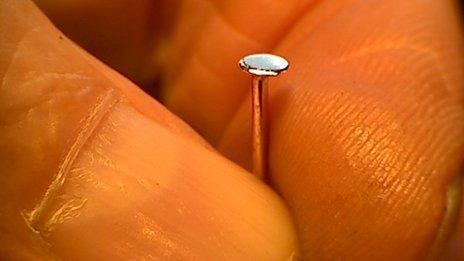£5 notes 'worth £20,000' in circulation
- Published

Graham Short engraved a 5mm portrait of author Jane Austen on the transparent part of the new plastic Bank of England £5 notes
Four special £5 notes, engraved with a tiny portrait of author Jane Austen, are being put into circulation and could be worth more than £20,000.
The first of four notes featuring art by specialist micro-engraver Graham Short was spent in Kelso in the Scottish Borders on Monday.
Three more notes will be spent in England, Wales and Northern Ireland this week.
Mr Short's last work, a portrait of the Queen on a pinhead, sold for £100,000.
The artist came up with the idea of engraving a 5mm portrait of Pride and Prejudice author Jane Austen on the transparent part of the new plastic Bank of England £5 notes, to mark the 200th anniversary of Austen's death next year.
He has included a different quote around each one, ensuring that each note is unique.
Anyone finding one of the notes has been advised to contact the Tony Huggins-Haig Gallery in Kelso, which launched the project.
Mr Huggins-Haig told BBC Scotland that the notes could be worth tens of thousands of pounds at auction.
He said: "All of Graham's work has an insurance valuation of about £50,000 at the moment. It's a reasonable estimate."
The artist and the gallery owner decided that rather than auction the notes globally, they would simply hand them out secretly and - after launching new art collections in Kelso at the weekend - the first one was spent in a nearby shop.
"I do know that the place that it was spent in haven't got a clue that it was spent in there," said Mr Huggins-Haig.

The serial numbers of the four notes will help to identify them
"It was spent somewhere where everybody goes in. It is not a chain, it was a local business."
He has sold Mr Short's work for some time and said they came up with the idea in an effort to take art out to a wider audience.
"Only 5% of people ever visit an art gallery," he said.
"How do we get art out and make it accessible to all?
"These notes are spent everywhere, so anyone has a chance of winning."
'Golden ticket'
He said if someone with a special note contacted the gallery they would provide advice on how to put the artwork up for auction.
The owner of the note could also hold on to it in the hope it increased in value.
"It is very much the Willy Wonka golden ticket," said Mr Huggins-Haig.
"I would like them to keep it, because it is a work of art, but it is up to them.
"They could sell it or they could hold on to it - they own it when they find it."
The Birmingham-born artist said he was always looking to do "something different" and as soon as he saw the new £5 notes he was keen to engrave something on one.
"I didn't know what but then I found out it was going to be the 200th anniversary of Jane Austen's death and her image is also going on the new £10 note, so it ties in nicely with that," said Mr Short.
"The beauty of this is that you can't see the engraving at all, but when you turn the note and the light comes at a different angle it appears. I call it invisible engraving."
'Currency defacement'
The four notes have the serial numbers AM32 885551, AM32 885552, AM32 885553 and AM32 885554.
The Bank of England's website states that it is illegal to deface bank notes, external under the Currency & Banknotes Act 1928.
It says it is against the law to "deface our banknotes (by printing, writing or impressing upon them words, letters or figures, etc.), although the question of whether or not to prosecute in individual cases is up to the police and the courts".
In a statement, the gallery said it had contacted the Bank of England, which informed them that the notes were still legal tender.
It went on: "When it comes to the idea that this is currency defacement, it may well be in the eyes of the Bank of England, but to Graham and us at the gallery, we haven't done this maliciously, we've joined together for this event to bring goodwill to those lucky enough to find the notes."
They said their only motive was to spread "good faith and happiness" through the country.
- Published1 May 2012
